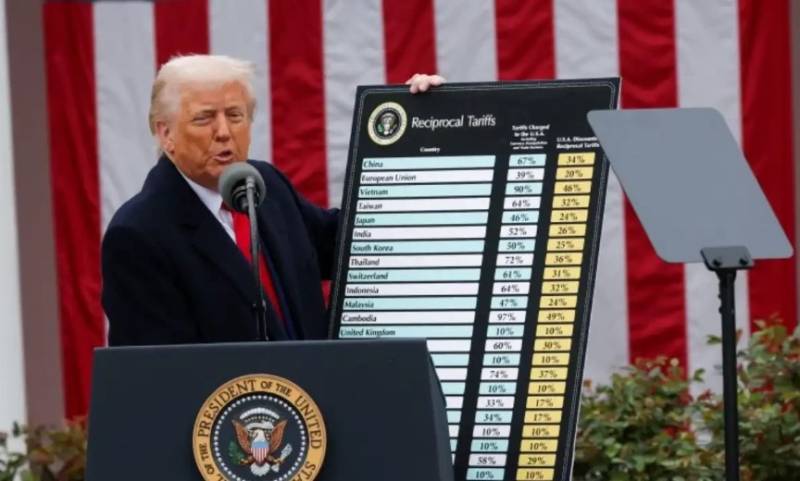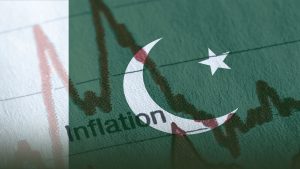Washington/Islamabad, April 09: US President Donald Trump’s sweeping tariffs on dozens of economies officially came into force on Wednesday, intensifying the already devastating global trade war.
The new measures include more than 100 percent in levies on Chinese goods, causing global markets to tumble once again.
Following the initial 10% tariffs that were imposed over the weekend, rates on US imports from major exporters such as the European Union and Japan were raised further at 12:01am (9:01am PKT) on Wednesday.
China, Washington’s top economic rival and a key trading partner, has been hit the hardest. With the latest measures, tariffs on Chinese products now total a staggering 104%.
Trump stated on Tuesday that his administration was working on “tailored deals” with select trading partners. The White House emphasized that allies like Japan and South Korea would be prioritized.
Trump’s top trade official, Jamieson Greer, told the Senate that countries including Argentina, Vietnam, and Israel had shown willingness to reduce their tariffs.
Speaking at a dinner with fellow Republicans on Tuesday night, Trump claimed, “These countries are calling us up, kissing my a**. I’m telling you, they’re dying to make a deal.”
Despite these remarks, Beijing has shown no signs of backing down, vowing to fight the trade war “to the end” and promising robust countermeasures to defend its economic interests.
China’s retaliatory tariffs of 34% on US goods are expected to take effect at 12:01am local time on Thursday (9:01pm PKT Wednesday).
President Trump remains convinced that his tariff strategy will revive the United States’ declining manufacturing base by forcing companies to shift production back to American soil.
However, many economists and business analysts have raised doubts over the feasibility and timing of such a shift, warning that the tariffs will likely fuel higher inflation as costs rise for American consumers and businesses.
Trump claimed on Tuesday that the US was “taking in almost $2 billion a day” from tariffs.
Initially, Trump had imposed a 34% additional tariff on Chinese imports. However, after China responded with an equivalent measure on American goods, the US administration retaliated further with an additional 50% duty.
Also Read: US Markets Crash as Trump’s Tariff Move Triggers 6% Oil Drop
Including earlier levies from February and March, the total cumulative tariff increase on Chinese goods now stands at 104% during Trump’s second term.
Trump maintained that the ball is in China’s court, asserting that Beijing “wants to make a deal, badly, but they don’t know how to get it started.”
He also revealed on Tuesday that a major new tariff on pharmaceuticals would be announced soon.
Meanwhile, Canada confirmed that its own tariffs on specific US auto imports would come into effect on Wednesday.
Markets in Meltdown
Global equity markets, already reeling from trillions of dollars in lost value in recent days, continued their downward spiral.
On Wednesday, Asian markets were hit hard, with Hong Kong plunging over 3% and Japan’s Nikkei shedding 2.7%.
Losses accelerated sharply after the new tariffs took effect, with Taiwan’s stock index dropping 5.8% by the afternoon.
Ahead of the European market open, stock futures indicated steep declines on the horizon.
The impact extended into foreign exchange markets, where the South Korean won dropped to its lowest level against the US dollar since 2009.
The Chinese offshore yuan also plummeted to an all-time low, as the People’s Bank of China moved to weaken the currency for the fifth consecutive day, according to Bloomberg.
However, analyst Stephen Innes cautioned that this slow depreciation strategy would not be enough to neutralize the impact of the tariffs.
“Letting the yuan grind lower at this measured pace won’t offset the blow from a full-blown tariff barrage,” he said. “The levies are simply too big. China is trying to thread the needle, but the runway is short.”
Oil prices also took a hit, with West Texas Intermediate (WTI) crude falling below $60 per barrel — the first time since April 2021.
Even global benchmark bonds, often seen as a safe haven during market turmoil, were caught in the sell-off. A wave of forced selling reflected investors’ rush to liquidate holdings in favor of cash.
Calls to Avoid Further Escalation
Amid rising tensions, the European Union is calling for calm. EU Commission President Ursula von der Leyen spoke with Chinese Premier Li Qiang, urging restraint and underlining the importance of global economic stability. She highlighted “the need to avoid further escalation,” according to an EU statement.
Premier Li responded by saying that China is confident in its ability to withstand the pressure, stating that the country is “fully confident of maintaining sustained and healthy economic development.”
The EU, which has faced Trump’s criticism over its own tariff regime, is expected to unveil a formal response next week to the 20% levies it now faces under the new US measures.
Also Read: Negligible Direct Impact on Pakistan: Trump Tariffs Determination
In retaliation for earlier US steel and aluminum tariffs, the European bloc plans to impose up to 25% tariffs on a range of American goods — from soybeans to motorcycles, according to a document obtained by AFP.
German Finance Minister Joerg Kukies warned on Wednesday that Europe’s largest economy could be headed for another recession as a direct result of the trade conflict.
Adding fuel to the controversy, Tesla CEO Elon Musk — a known critic of Trump’s trade policies — took a public jab at senior White House trade advisor Peter Navarro, calling him “dumber than a sack of bricks.” Musk made the comment after Navarro dismissed Tesla as merely a “car assembler” reliant on cheap foreign parts.









